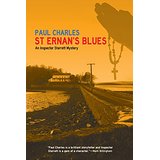
What is your
relationship with the Donegal coastline described in the books?
My
wife Catherine is from Donegal and I’ve many friends there. Geographically
speaking it’s very isolated and has not been overdeveloped or spoiled, and it
has a stunning landscape with breath-taking coastline and a big sky. It’s naturally very soulful too, and if you
can avoid the showers you can find some of the best beach-walks in the world. A
few years before I started work on the Starrett stories I started to spend a
lot of time there and everything I needed location-wise for this series was
right there slap bang on my door step.
Why did you set the
novel in a “retirement home” for priests?
I
really wanted to write this Starrett story in the Agatha Christie tradition.
Instead of having the victim and all the suspects on a train or a ship, I
thought a Donegal retirement home for priests would serve perfectly as my
“locked room”.
Is St Ernan’s is a real
place – and what made you set the story there?
Yes
St Ernan’s is very much a real place. I’m always discovering that real
locations are infinitely more interesting than fictional ones. I was intrigued
by St Ernan’s from the first moment I encountered it and bit by bit discovered
the history of the Island – many of the stories about the house are true and
have been included in an attempt to try and make fiction read as real.
When
I was researching the book I tried several times to fix up a visit to the house
and the island. The owner was very polite; the times weren’t convenient, maybe
check in again in a few months. Eventually he agreed I could come over and
Catherine dropped me off by the front door and she and her father Gerry and our
two nephews went off for a drive around Donegal Town. I was always conscious I
was encroaching on the owner’s time and tried really hard to do the swiftest
possible tour of the house, while keeping my wish for an investigative walk around
the island to myself. Don’t get me wrong, the owner was at all times very
hospitable, but I believe by the time Catherine returned to pick me up, his
sigh of relief was definitely audible.
As he walked me out to the car and we were saying our goodbyes, he
thought he recognised someone in the car.
“Is that Gerry McGinley?” he asked.
“It is indeed,” I replied.
“How do you know Gerry?” he asked,
quickly walking over to the car.
“He’s my father-in-law,” I replied.
“Sure you should have told me that,” he
said, as he opened the car door and started shaking Gerry’s hand furiously.
My
father-in-law was a much-loved legend in Donegal; very sadly he has since
passed. But once the owner knew him everything changed. As he chatted away to
Gerry he invited me to have an explorative dander around the island and “go and
look around the house again if you want to”. When I returned they were still
chatting away nineteen to the dozen.
From
their chat I got a sense of the old Donegal, of how people dealt with each
other, and of how, when someone knows you’re connected to people they know and respect, they are prepared to offer you
the same genuine hospitality friends of theirs would get in return, were the situation ever reversed.
Did you feel nervous
about broaching the subject of abuse in the Catholic Church?
No
not at all. Just like for every
less-than-perfect priest, there are literally 1,000s of priests who are decent
God-fearing people. For instance, in St
Ernan’s Blues Fr. Robert O’Leary, at least appears to show the other side
of the coin.
How do you approach a
character like Starrett upon whom a whole series of books is based?
When
I was working on I’ve Heard the Banshee Sing, a DI Christy Kennedy mystery,
Kennedy finds himself making a quick
trip into Donegal where he meets up and works with a local Gardai
inspector. When I started to consider this Gardai Inspector – even thought it
was a small part – I tried to make him come alive and consider his story… and
out he came. I like the character a lot. In a weird way it’s like he was there
already and I met him and got to know him the way you meet and get to know
someone who becomes a good friend.
Later
I was invited to do a short story for Meeting
Across The Water – a collection of crime stories based on the Bruce
Springsteen lyric – and the idea I had was more suitable for Starrett than it
was for Kennedy. A bit more of Starrett’s character came through and I was on
my way.
There is something
rather nostalgic in your books, a yearning for a simpler time. Does that
reflect your own feelings about the world?
I
think it does, yes, but at the same time I try really hard to balance it out so
that it doesn’t read like a “good old days” manifesto because the good old days
are good and gone and some of them weren’t really all that good.
Do you plot your stories
before you start, or do they unfold and surprise you as you go along?
I
do a lot of work and research beforehand, as was the case with St Ernan’s Blues, with the island and
the house and even Donegal Town itself. I also spend quite a bit of time
putting my cast of characters together. I don’t like people just to appear on
the page – I need to make them real to me to be able to complete the process.
However, I love to start each book the way a detective starts off a real
investigation and to go on the journey with Starrett. So I go the book each day
to try to discover (like the detective, and hopefully the reader) what happened
and to solve the puzzle of the crime. With the DI Christy Kennedy mysteries I
always do a lot of work and research on the unique method of murder. So I’llstart with a perfect murder and then work backwards from there to try to figure
out it happened.
Do you read widely
within the crime genre, and if so, who
inspires you most?
Oh
yes – I positively devour crime books, both true crime and fiction. I love
Norman Mailer’s The Executioner’s Song,
where he writes a true crime story as a novel, a process I try to reverse. In Cold Blood by Truman Capote is
another major achievement. John
Connolly’s books I love, and then Michael Connelly as well. Colin Dexter’s
books are such a joy to read and re-read.
The moralising of the
church, and the strict code by which its members are supposed to live provides
an interesting opportunity to scrutinise people's decisions and their
motivations in the book. Was this your original intention?
It
was certainly something I wanted to examine. I’ve always felt that there are
bad people and there are good people and if you’re a priest it doesn’t necessary
make you a good person and if you’re a crook
it doesn’t necessary make you a bad person. People are people and we all
deal with our foibles the best we can.
There's some great
attention to details in the police procedural aspects of the book. Have you
spent time with police officers in the course of researching your books?
I
haven’t. I’ve always found it best to observe while being unobserved.
Do you have any further
plans for Inspector Starrett?
Well
there are a couple of Starrett short stories I can’t wait to do. When I started
work on the first Starrett book – The
Dust of Death – I had some of the main ideas, mainly Starrett’s back story,
for the first three (Family Life and
now, St Ernan’s Blues). I have an
idea for the next one, which is pretty much suggested at the end of St Ernan’s Blues but I’m currently
working on the second McCusker, A Day In
The Life of Louis Bloom and then I’m looking forward to getting started
into writing the 11th Christy Kennedy Mystery.
 St Ernan's Blues
St Ernan's Blues
An Inspector Starrett Mystery
Paul Charles
Dufour Editions
June 16th 2016
Priced £18.99
Read SHOTS' Review